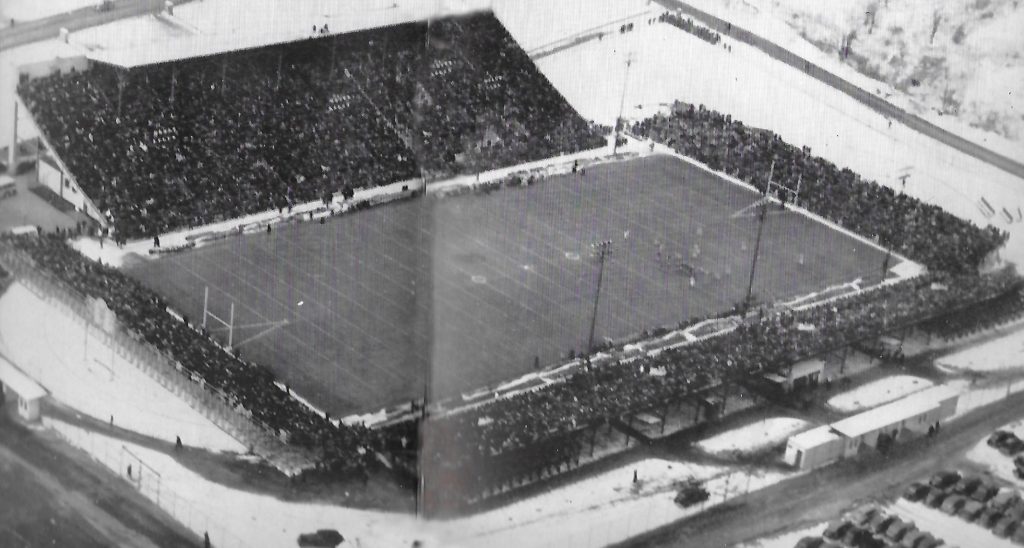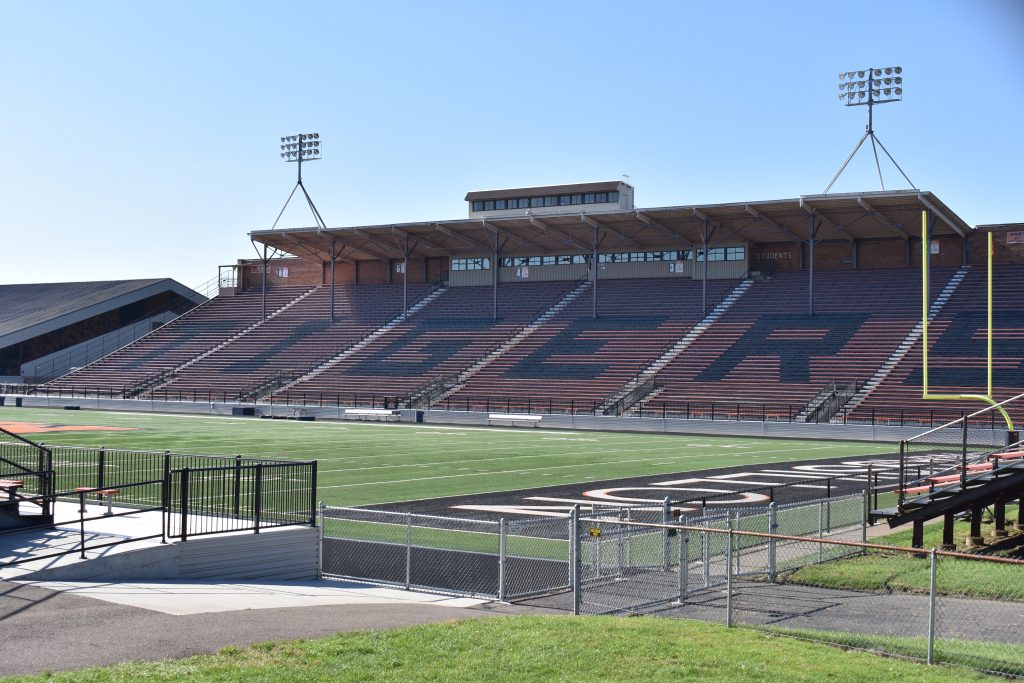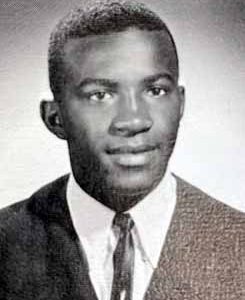
In 2019 Paul Brown Tiger Stadium will celebrate its 80-year anniversary. Constructed in 1938-39 during the coaching tenure of the great Paul Brown, it has hosted hundreds of high school football games in front of over 3 million fans. It has also been used for state football playoff and all-star games, fireworks displays, high school graduations and band reviews. Below is an article that appeared in the game program for the Massillon vs. Cleveland Cathedral Latin contest, dated September 15, 1939, in conjunction with the opening of Tiger Stadium. The publication describes the thought process, funding and construction that made Tiger Stadium a reality.
Tiger Stadium is one of ten units in an $860,000 school building program being carried out in Massillon this year with the assistance of the Public Works Administration (PWA).
Of that $860,000, Massillon citizens will pay $473,000 and the federal government will contribute the remaining $387,000.
Tiger Stadium is the first of these units to be dedicated. It is situated in a 57-acre tract of land the city park commission purchased in 1930 from the late City Board of Trade, and which was improved for park purposes by the Works Progress Administration (WPA) at a cost of $160,000.
When the Board of Education found it impractical to expand its athletic facilities at Massillon Field, it turned elsewhere for a stadium site, and finding the new park land suitable, offered to trade Massillon Field to the City Park Commission for five acres of land.
The commission agreed, the exchange was completed and today this section of South Sippo Park is being turned into a playground for Massillon school children. It will be known as Massillon School Field and will have facilities for football, baseball, football practice, a band drill field, tennis courts, archery courts and parking space for 5,000 autos.

Tiger Stadium, which stands at the northeast corner of Massillon School Field, is a monument to the glories attained by Massillon’s sons on the professional as well as the scholastic gridiron. For here, professional football was born, nurtured and made one of America’s leading sports; and when professional football outgrew Massillon, the city’s high school carried on the Tiger championship gridiron tradition.
Both the PWA and the WPA participated in the construction of Tiger Stadium. The spacious steel and brick tile stands on the west side of the field and the fence surrounding it was designed by Albrecht and Wilhelm, local architects, and built by the Warren Hoffman Co. of Canton at a cost of $118,000. The grading of the field, construction of tile drains and seeding was financed by the Board of Education. The stands on the east were taken down, moved from Massillon Field and erected by the WPA, which also set the curbing for the running track and constructed storm and sanitary sewers.
The WPA likewise is widening roads leading to Massillon School Field, as well as driveways in the athletic grounds, constructing gutters, tennis courts, a baseball diamond, a band drill field, a practice field for football, archery courts and parking grounds for autos.
When completed, Massillon School Field with its Tiger Stadium will represent a $225,000 project. Of this entire project, the Federal Government has contributed $136,000, Massillon citizens $89,000.
The actual cost to the taxpayer is twelve and one-half cents per year for each thousand dollars worth of real estate he owns. The cost of financing the stadium project is nine cents per $1,000, while that of the recreation field is three and one-half cents per $1,000.
Tiger Stadium has 12,000 permanent seats. The stands on the west side will comfortably seat 7,650 patrons and that on the east side 4,250. The seats at the south end of the field are portable and will accommodate 2,000. It is probable that at the close of the football season they will be taken down, stored and erected next spring on the baseball diamond.
The overall height of the steel and brick tile stands is 60 feet while the last of the 40 rows of seats is 42 feet above the playing field. Two hundred and seventy-seven tons of structural steel support the stands. Seven hundred and fifty cubic yards of concrete were used in the structure.
The stadium contains 10,000 square feet of floor space, with accommodations for home team, visiting team, officials, ticket and faculty managers, concessions, public and private lavatories, storage space and a band room. These rooms are heated with two complete units, one for the visiting team and one for the home team’s headquarters.
Topping the stands is a 72-foot press box, one of the finest in the state, enclosed with glass, with radio compartment and telephone connections. The electric scoreboard at the south end of the field is operated from the press box.
The playing field, used as a baseball diamond for South Sippo Park, was re-graded for football, requiring the moving of 2,500 cubic yards of soil. Six thousand feet of drain tile were placed beneath the surface. A ton of fertilizer and 600 pounds of grass seed made possible the fine sod. This field will be illuminated with 135,000 watts of light flowing from 80 reflectors mounted on eight 60-foot poles. The reflectors are of latest design, each equipped with a lens.
A running track encircles the playing field. Twenty-five car loads of ashes were required to fill it.
The entire stadium is encircled by 2,200 feet of fence, 10 feet in height with an additional foot of barbed wire strands.
Though Tiger Stadium, and particularly Massillon School Field, are not entirely completed, the progress has been amazing, considering that ground was not broken until the first week of April.
The PWA share of the project has given 33,000 hours of work to men in Massillon and vicinity, while the WPA portion of the program will provide jobs for 250 men for six months.





